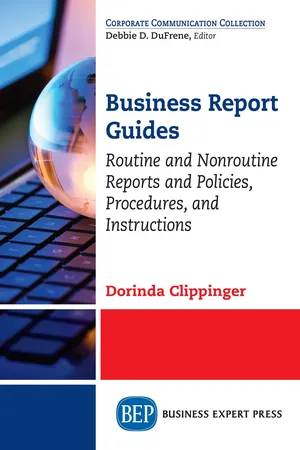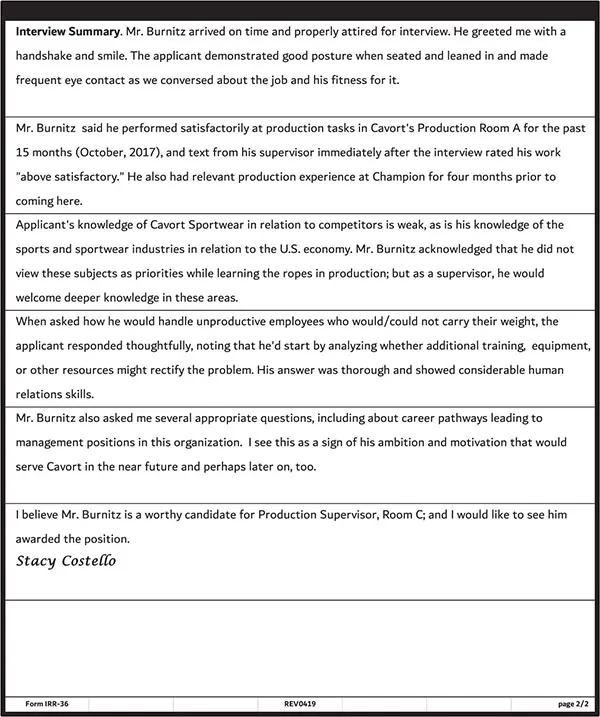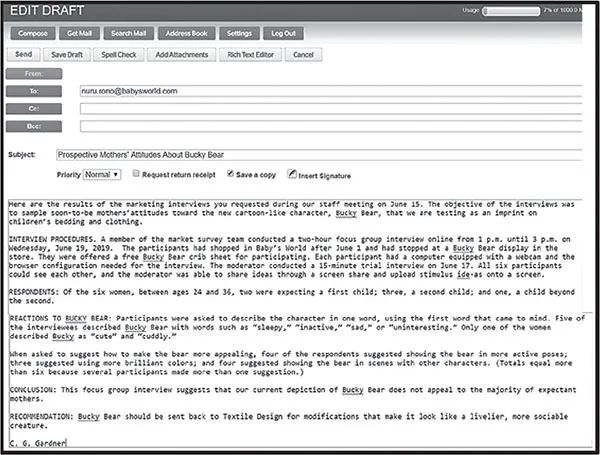
eBook - ePub
Business Report Guides
Routine and Nonroutine Reports and Policies, Procedures, and Instructions
- 240 pages
- English
- ePUB (mobile friendly)
- Available on iOS & Android
eBook - ePub
Business Report Guides
Routine and Nonroutine Reports and Policies, Procedures, and Instructions
About this book
This book includes reports that managers originate often, reports they may create occasionally, organizational policies, procedures, and work instructions.
Inside, the reader will discover guides for creating over 20 diverse reports; designing report forms; planning, writing, and formatting narrative reports; producing digital and print employee manuals; and locating the service providers and software that can improve your reports' cost-effectiveness.
A crisp writing style, bullet points, and many authentic examples and visuals convey essential information quickly. Each chapter summary includes checklists. Business Report Guides gives ample information to apply instantly. It also works as a handy reference for use throughout your career.
Frequently asked questions
Yes, you can cancel anytime from the Subscription tab in your account settings on the Perlego website. Your subscription will stay active until the end of your current billing period. Learn how to cancel your subscription.
No, books cannot be downloaded as external files, such as PDFs, for use outside of Perlego. However, you can download books within the Perlego app for offline reading on mobile or tablet. Learn more here.
Perlego offers two plans: Essential and Complete
- Essential is ideal for learners and professionals who enjoy exploring a wide range of subjects. Access the Essential Library with 800,000+ trusted titles and best-sellers across business, personal growth, and the humanities. Includes unlimited reading time and Standard Read Aloud voice.
- Complete: Perfect for advanced learners and researchers needing full, unrestricted access. Unlock 1.4M+ books across hundreds of subjects, including academic and specialized titles. The Complete Plan also includes advanced features like Premium Read Aloud and Research Assistant.
We are an online textbook subscription service, where you can get access to an entire online library for less than the price of a single book per month. With over 1 million books across 1000+ topics, we’ve got you covered! Learn more here.
Look out for the read-aloud symbol on your next book to see if you can listen to it. The read-aloud tool reads text aloud for you, highlighting the text as it is being read. You can pause it, speed it up and slow it down. Learn more here.
Yes! You can use the Perlego app on both iOS or Android devices to read anytime, anywhere — even offline. Perfect for commutes or when you’re on the go.
Please note we cannot support devices running on iOS 13 and Android 7 or earlier. Learn more about using the app.
Please note we cannot support devices running on iOS 13 and Android 7 or earlier. Learn more about using the app.
Yes, you can access Business Report Guides by Dorinda Clippinger in PDF and/or ePUB format, as well as other popular books in Business & Business Skills. We have over one million books available in our catalogue for you to explore.
Information
CHAPTER 2
Writing Nonroutine Reports
The need to write or read reports differs for everyone almost daily. As you carry out your work, you sometimes confront circumstances, make decisions, or take actions that deviate from your normal routine yet fall within your range of responsibility. These situations often require that you report your actions or decisions to upper-level management, your subordinates, or even to the public or stockholders. Those reports may be classified as nonroutine reports.
Naturally, this book cannot illustrate all nonroutine reports that you may encounter. However, it will present the following nonroutine reports that you might send and receive.
- Interview reports: individual job applicant, focus group
- Recommendation reports: justification report, feasibility report
- Public relations (PR) reports: press release, fact sheet, and backgrounder
- Marketing reports: whitepaper and business proposal
- Summaries: abstract, overview, and executive summary
Interview Reports
Although you may not interview people regularly in your job, you may occasionally be requested to interview a job applicant to your company. Additionally, you may now and then be on a special project team that requires you to obtain critical information by interviewing a group of people. In both cases, rather than provide verbatim transcripts of your interviews, you will likely be expected to condense the information you obtained in a report to whomever asked you to conduct the interview.
Individual’s Interview Report
Appropriate content for an interview report includes the following information.
- When, where, and how the interview was conducted
- Summary of the information obtained
- Relevant comments about the interview experience, such as problems encountered or recommendations related to interview procedure.
Figure 2.1 demonstrates an interview report for an individual job applicant.

Figure 2.1 Interview report for individual job applicant

Figure 2.1 (Continued)
Following these guidelines will help you write an effective interview report.1
- Introduction. State the subject’s name and position applied for, along with the date, time, and location of the interview. In addition, state how you expect the interview information to be used and why you conducted the interview, since interviewing job applicants is not one of your regular duties.
- Discussion. Give a summary of topics discussed in the interview. Also, comment on the nature, or themes, of the applicant’s answers, without going into detail.
- Findings. Write about your findings during the interview; that is, state what you learned about the job applicant. If the interview revealed unexpected information that is altogether relevant to the interview’s purpose, discuss that information briefly.
- Circumstances. Write about the interview context, too. Explain any ways that the setting—such as distracting noises or blasts of cold air—may have affected the interview. Comment on the interviewee’s behavior, mannerisms, and reactions to your questions.
- Summary. Recap the report, emphasizing your major findings. Restate your plans for using the information gathered in the interview.
Focus Group’s Interview Report
Focus group interviews are often used to determine interest in a new product or service, the effectiveness of advertising and communications research, background studies on consumers’ frames of reference, or consumer attitudes and behaviors toward an idea, organization, and so on.2
The standard focus group interview involves six to twelve similar individuals—such as male customers, young professionals, or those who regularly purchase a certain laundry detergent—who are brought together to discuss a topic. The respondents are selected according to the relevant sampling plan and meet at a central location that has equipment to make an audio or audiovisual record of the discussion. Note: In recent years, online focus groups have been increasingly useful for consumer research. An interviewer, also called a facilitator or moderator, invites vetted interviewees to sign into a web conference at a pre-arranged time and to participate in an online focus group.3
In face-to-face and online focus groups, the facilitator keeps discussion moving and focused on the topic. Usually the interviewer also analyzes the transcript or recording of the session and prepares a summary of the meeting. Figure 2.2 shows a focus group interview report.

Figure 2.2 Focus group interview report
Both interview reports provide the information necessary for others to evaluate the interviews and...
Table of contents
- Cover
- Halftitle
- Title
- Copyright
- Abstract
- Contents
- Preface
- Ack
- 01-Chapter 01
- 02-Chapter 02
- 03-Chapter 03
- 04-Appendix A
- 05-Appendix B
- 06-Notes
- 07-References
- 08-Author Bio
- 09-Index
- 10_Adpage